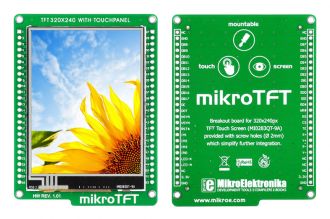
We strongly encourage users to use Package manager for sharing their code on Libstock website, because it boosts your efficiency and leaves the end user with no room for error. [more info]

Rating:
Author: MIKROE
Last Updated: 2013-07-02
Package Version: 1.0.0.0
Example: 1.0.0.0
Category: Graphics & LCD
Downloaded: 3287 times
Not followed.
License: MIT license
This is a sample program which demonstrates the use of mikroTFT board.
Do you want to subscribe in order to receive notifications regarding "mikroTFT - Example" changes.
Do you want to unsubscribe in order to stop receiving notifications regarding "mikroTFT - Example" changes.
Do you want to report abuse regarding "mikroTFT - Example".
| DOWNLOAD LINK | RELATED COMPILER | CONTAINS |
|---|---|---|
| 1372776746_mikrotft___examp_mikrobasic_arm.RAR [274.78KB] | mikroBasic PRO for ARM |
|
| 1372776778_mikrotft___examp_mikroc_arm.RAR [274.23KB] | mikroC PRO for ARM |
|
| 1372776829_mikrotft___examp_mikropascal_arm.RAR [274.78KB] | mikroPascal PRO for ARM |
|

mikroTFT is a breakout board for MI0283QT-9A 2.8" TFT color display with 320 x 240 pixel resolution, driven by ILI9341 display controller. TFT display is covered with a resistive touch panel which can be used as an input device. For further connectivity two 1x26 side headers are provided. Mounting holes (ø 2.29 mm) located in each corner simplify integration. Board is designed in the same form factor as mikromedia boards. This allows you to easily switch from mikroTFT to mikromedia, and vice-versa, while retaining most of the integration features.
Examples are provided for STM32F107VC microcontroller, written in mikroC, mikroBasic and mikroPascal compilers for ARM.